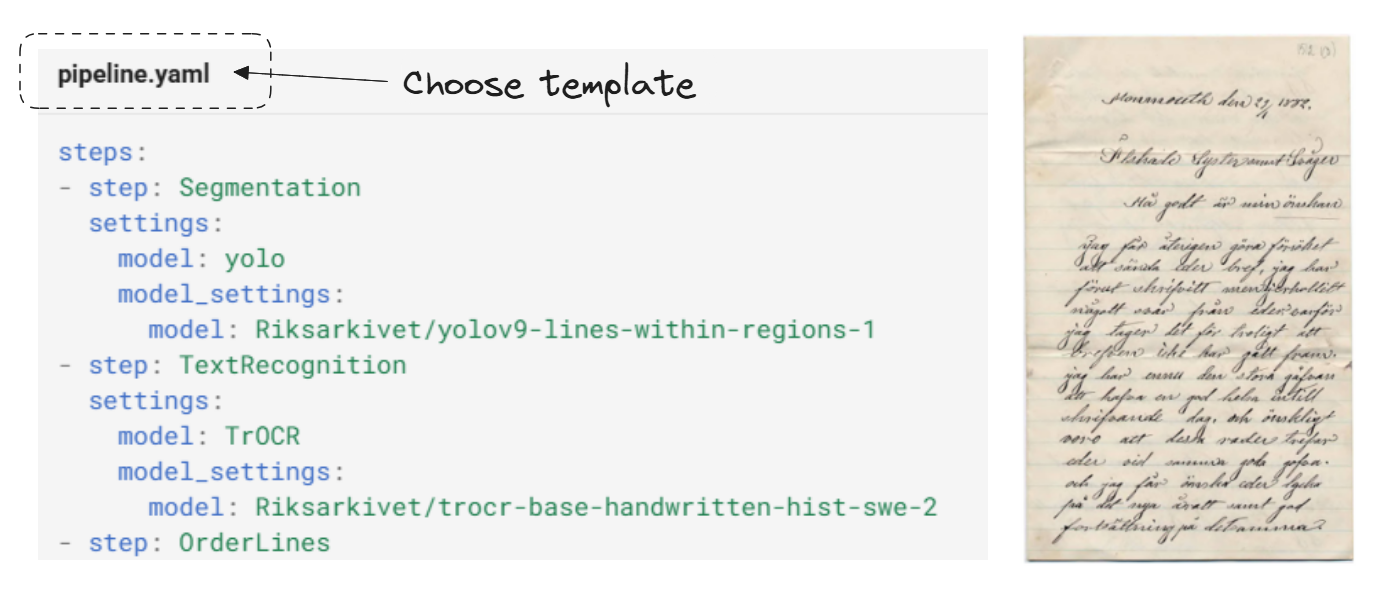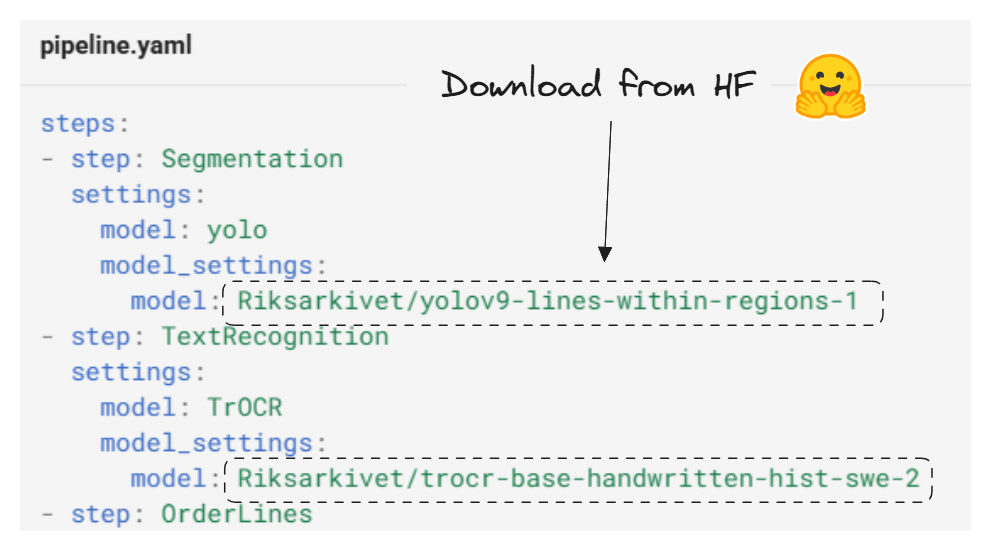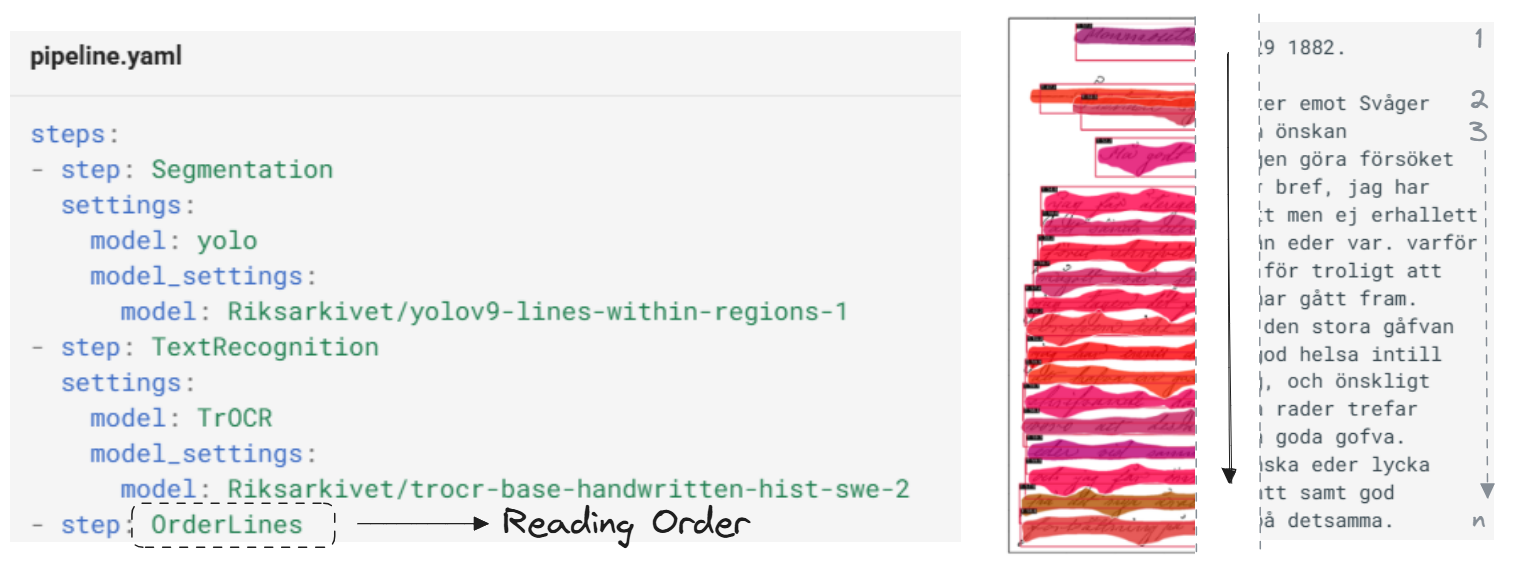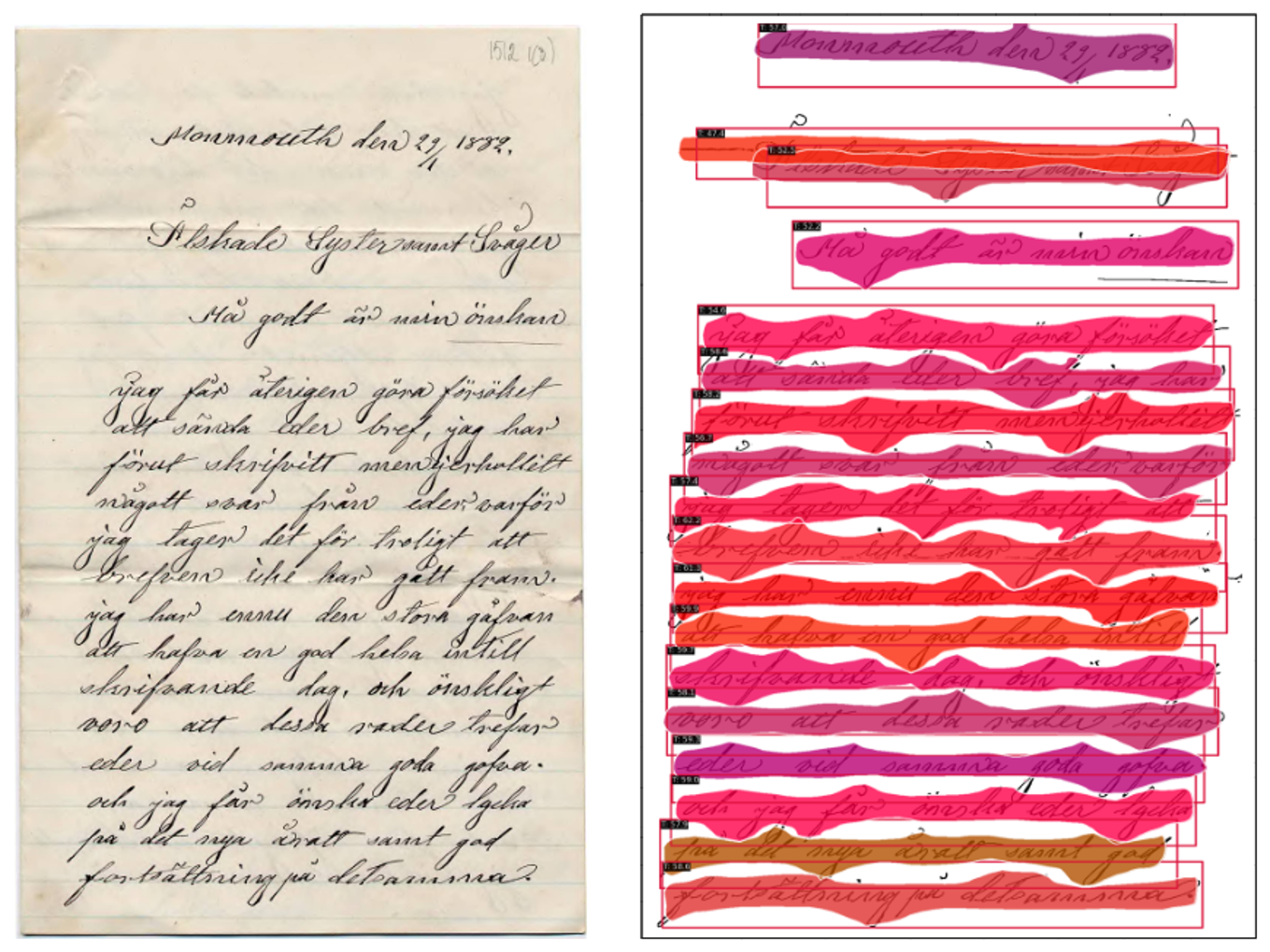Pipeline¶
Welcome to the HTRflow Pipeline documentation. This section introduces the modular pipeline framework designed to process handwritten text images using customizable "pipeline" steps. You can define your pipelines using YAML configuration files or Python code.
Pipeline Guide¶
This guide provides an overview of the pipeline architecture, explains some of the available steps, and shows you how to configure and run your pipelines for handwritten text recognition tasks.

The following images illustrate how YAML pipeline templates function. The example below serves as a template for common document types such as letters, notes, and individual pages.
steps:
- step: Segmentation
settings:
model: yolo
model_settings:
model: Riksarkivet/yolov9-lines-within-regions-1
- step: TextRecognition
settings:
model: TrOCR
model_settings:
model: Riksarkivet/trocr-base-handwritten-hist-swe-2
- step: OrderLines
Tip
See Example Pipeline for inspiration of templates.
Understanding YAML Pipeline Templates¶
Each template is designed for specific document types – the example below shows a template optimized for single-column running text, such as letters, notes, and individual pages.

Pipeline Steps¶
Each pipeline consists of sequential steps executed from top to bottom. In this example, we focus on two primary steps:
- Segmentation: Identifies and extracts text lines from the image.
- Text Recognition: Performs Handwritten Text Recognition (HTR) on the segmented lines.

Model Integration¶
Models specified in the pipeline can be downloaded directly from the Huggingface model hub. For a comprehensive list of supported models, refer to the HTRflow Models Documentation.
Note: For English text recognition, you'll need to specify an appropriate model ID, such as the Microsoft TrOCR base handwritten model.

Processing Workflow¶
These steps illustrate how an input image is transformed into recognized text through a series of targeted operations. Each step is designed to progressively refine the data, ensuring that the final output is both accurate and well-organized.
Text Line Detection¶
The first step is to identify and extract individual text lines from the input image. In this phase, a dedicated model detects the boundaries of each text line, segmenting the image into smaller, manageable parts.

Text Recognition¶
Once the text lines have been isolated, they are forwarded to the Handwritten Text Recognition (HTR) component. This stage involves decoding the visual patterns into machine-readable text. The HTR model is specifically optimized for interpreting handwritten text, ensuring that even challenging scripts are transcribed accurately.

Reading Order Determination¶
After the text has been recognized, the final step is to arrange the text lines in the correct reading order. This is crucial when dealing with documents that may have complex or non-linear layouts. In this example, a simple top-down ordering transformation is applied, ensuring that the extracted text flows naturally from one line to the next.

There are additional steps available, and you can also configure your own custom steps. See Pipeline steps for more details.
Pipeline steps¶
HTRflow pipelines operate on Collection instances. A Collection represents one or several input images. Each pipeline step takes a Collection and returns an updated Collection. Here is a toy example of a pipeline step in python:
class ExampleStep(PipelineStep):
def run(self, collection: Collection) -> Collection:
for page in collection:
# Do something
return collection
The step is based on PipelineStep, which is the common base class of all pipeline steps. It is defined by overriding the run method.
A pipeline step may take arguments at initialization time. Here is an example pipeline step with a value argument:
class ExampleStepWithArgument(PipelineStep):
def __init__(self, value):
self.value = value
def run(self, collection: Collection) -> Collection:
for page in collection:
if self.value:
# Do something
return collection
Tip
See Reference for a list of all predefined pipeline steps.
Defining a pipeline¶
A pipeline is a sequence of pipeline steps. HTRflow offers two ways of defining pipelines: As YAML files or in Python code.
YAML¶
YAML pipelines are used with HTRflow's CLI and offers a no-code interface to HTRflow. Here is a one-step YAML pipeline that would run ExampleStep():
Arguments can be passed to steps by adding settings. Any key-value pairs under settings are forwarded to the step's constructor. This pipeline would run ExampleStep() followed by ExampleStepWithArgument(value=0.5):
Use the htrflow pipeline command to run a YAML pipeline:
The path/to/inputs should point to a single image (for example, images/image0.jpg) or a directory of images (for example, images).
Python¶
Pipelines can also be defined directly in python code. The above pipeline is equivalent to this code snippet:
from htrflow.pipeline import Pipeline
from htrflow.volume import Collection
collection = Collection.from_directory("path/to/inputs")
pipeline = Pipeline(
[
ExampleStep(),
ExampleStepWithArgument(value=0.5)
]
)
pipeline.run(collection)
Loading YAML Files with python¶
You can easily define and execute your pipelines by loading a YAML configuration file with the HTRflow package. This allows you to quickly modify your pipeline settings without changing your code.
Below is an example demonstrating how to load a YAML configuration from a string (or file), create a pipeline, and run it on your input images:
from htrflow.pipeline.pipeline import Pipeline
from htrflow.volume.volume import Collection
from htrflow.pipeline.steps import auto_import
import yaml
# Define the YAML configuration as a string.
my_yaml = """
steps:
- step: Segmentation
settings:
model: yolo
model_settings:
model: Riksarkivet/yolov9-lines-within-regions-1
- step: TextRecognition
settings:
model: TrOCR
model_settings:
model: Riksarkivet/trocr-base-handwritten-hist-swe-2
- step: OrderLines
- step: Export
settings:
format: txt
dest: outputs
"""
# Load the YAML configuration.
config = yaml.safe_load(my_yaml)
# Specify your images path or folder.
images = ['./my_image.jpg']
# Create a pipeline instance from the loaded configuration.
pipe = Pipeline.from_config(config)
collection = Collection(images)
# Run pipeline
collection = pipe.run(collection)
print(collection)
In this example:
- YAML Configuration: The
my_yamlstring defines a pipeline with four steps: Segmentation, TextRecognition, OrderLines, and Export. - Loading YAML: The configuration is loaded using
yaml.safe_load(my_yaml). - Pipeline Creation: A pipeline is created using
Pipeline.from_config(config). - Image Importing:
Collectioncan take list of image paths. - Pipeline Execution: The pipeline is run on each collection, and the final output is printed.
This method enables you to experiment with different pipeline configurations effortlessly by simply modifying the YAML file.
Example pipelines¶
Simple layout¶
Letters, notes, single pages, and other single-column running text only need one Segmentation step. This pipeline uses a Segmentation step with the Riksarkivet/yolov9-lines-within-regions-1 model to find lines to transcribe. Those lines are then transcribed by a TextRecognition step, ordered by OrderLines and finally exported as plain text.
steps:
- step: Segmentation
settings:
model: yolo
model_settings:
model: Riksarkivet/yolov9-lines-within-regions-1
- step: TextRecognition
settings:
model: TrOCR
model_settings:
model: Riksarkivet/trocr-base-handwritten-hist-swe-2
- step: OrderLines
- step: Export
settings:
format: txt
dest: outputs
Example output from segmentation step:

Nested segmentation¶
Segmentation steps can be chained to create a nested segmentation. In this pipeline, the first Segmentation step uses a model that segments the page into regions. Those regions are then segmented into lines by another model in the next Segmentation step. Inference steps such as Segmentation and TextRecognition always works on the leaf nodes of the document tree, so the TextRecognition step will only transcribe the line images, and not the regions. This pipeline uses two Export steps to export the results as both plain text and Alto XML.
steps:
- step: Segmentation
settings:
model: yolo
model_settings:
model: Riksarkivet/yolov9-regions-1
- step: Segmentation
settings:
model: yolo
model_settings:
model: Riksarkivet/yolov9-lines-within-regions-1
- step: TextRecognition
settings:
model: TrOCR
model_settings:
model: Riksarkivet/trocr-base-handwritten-hist-swe-2
- step: ReadingOrderMarginalia
- step: Export
settings:
format: txt
dest: text-outputs
- step: Export
settings:
format: alto
dest: alto-outputs
Example output from multiple (nested) segmentation steps:

Example snippets¶
This section provides some example snippets that can be pasted into an existing pipeline. For more details and pipeline steps, read the Pipeline steps reference.
Generation configuration¶
A model's generation settings can be controlled by including generation_settings. Different models support different arguments here. For example, transformers-based models such as TrOCR accept the same arguments as model.generate(). Check the Model reference for details about each model. Here, we set num_beams=4 to use beam search instead of greedy decoding.
- step: TextRecognition
settings:
model: TrOCR
model_settings:
model: Riksarkivet/trocr-base-handwritten-hist-swe-2
generation_settings:
num_beams: 4
Multiple output formats¶
Chain Export steps to export results to different formats.
- step: Export
settings:
format: txt
dest: outputs
- step: Export
settings:
format: json
dest: outputs
Export partial results¶
An Export step can be placed within a pipeline to export partial results. Here, an Export step is used to export the raw results before post-processing, and another Export step exports the results after post-processing.